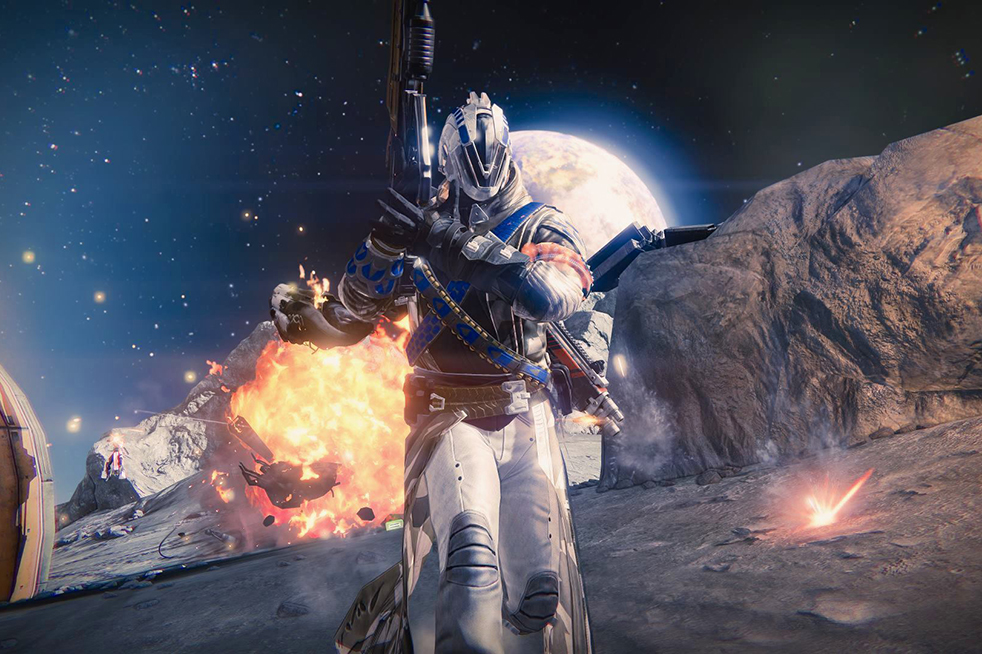“Destiny” was bound to become a legend with an estimated half-a-billion dollars dumped into the project and direction from Bungie and Activision.
Many gamers quickly deemed “Destiny” their most anticipated game of the year, due to excitement built up by multiple showings at numerous trade shows and innumerable advertisements on various forms of media.
A diversified array of guns, armor, ships and classes definitely impressed fans. However, the most exciting asset was arguably the ability to explore the Moon and the planets Venus and Mars, all of which are showcased on “Destiny: Planet View”, a browser-based explorer.
“Destiny” has a battle gameplay that is alluring and reminiscent of Bungie’s famed “Halo” saga. The same immersive experience of “Halo: Reach” washes over the screen when playing “Destiny”, reflecting similar health regerneration systems, tight controls, and a familiar art style.
Unfortunately this similarity means it is tremendously obvious that the enemies in “Halo” were slapped with new skins and backstories. Begrudgingly ignoring this is necessary to enjoy and learn the game-play styles of their races.
New additions such as rechargeable grenades (not number-based) and other small details have been added, but gun- and melee-based battle still carry a “Halo” feel.
Slight diversity within gameplay is allowed due to the organization of three classes of legendary heroes, Guardians: the Titan class are brutish warrior-type fighters, Warlocks are the agile mage class and the Hunters serve as the sneaky rogues. Each character type highlights a different experience.
As players gain more levels certain unique class abilities are added. The true breadth of a character’s original intent only becomes accessible in the second half of the thirty-level cap within the game.
Particular classes are advantaged by specific guns and armor, which are classified by type, power level and armor level, but all are available to each class. Different races such as Human, Awoken (alien) and Exo (robot) attempt to give credence to an underlying plot within the game, but this is where the game tends to disappoint.
Though a vast historical backstory appears to be woven into the premise of “Destiny”, the small bit of plot introduced in the beginning of the game is the only story worth noting.
The development team set themselves up for a compelling narrative with varied types of aliens on each planet, different races of playable creatures and the potential of different plot lines with each planet. However, this possibility of complex intrigue is quickly shot down once the first story mission is played. The game is revealed to operate just like any first-person shooter created before, with little to no real consequence for the player’s actions.
The saving grace to this possible frustration is the cooperative play. All missions can be played on your own or with two other friends, which truly brings out the best of what the game has to offer.
The influence from Activision, or at least the Blizzard Entertainment division, is notable when entering the mission field with a friend: small nuances of World of Warcraft and other MMO’s within the gameplay are apparent and welcome. However, this can lead to a slight nuisance with the “always online” aspect of the game.
One would believe that with the 60 dollar data downloaded to a drive or disc, there could be a way to simply cancel out the other players mindlessly scattering across locations to continue the processed mission. This would be a welcomed function in the game, but, sadly is not an option whether playing on the character creation screen or deep within an objective in the game. This means anyone could simply pass time hitting a gravity ball in the Tower (a combat-free area to buy supplies and meet other players) or exploring the final section of a cave battling off the Hive, and as soon as there is an internet fluctuation, the player could immediately get kicked from their game. Therefore, players are left completely at the mercy of their internet connections.
It becomes very frustrating to play missions on higher difficulties for extended periods of time and have the internet drop. This forces the player to allocate several minutes to deal with trivial nuances in order to restart the mission all over again.
It is painful as a player to watch a game that was never branded and publicized as an MMO game to be completely crippled under these conditions. A tower full of NPCs would be preferable to a game which brings worrisome thoughts upon boot-up.
The cooperative play is a wonderful feature in the game and in theory works very well, so having it is a huge plus. However, it would be nice to have the ability to play by one’s lonesome sometimes to retain some player independence.
“Destiny” within itself is too young to handle fluctuations in internet speed, like “World of Warcraft” and “League of Legends”. To compare seems almost vindictive, but when a college student cannot play a newly purchased game on day one because of a non-seamless Internet connection, then the developers garner the blame.
These are only initial thoughts though, since the title has only been out for 10 days. Therefore there is still much to discover and critique.
Despite its lack of story and frustrating online dependency,
“Destiny” is addictive and has a certain charm that compensates for most of its problems. Considering its supposed 10-year longevity, it will definitely keep hold as we move forward into this new console generation.
If awe-inspiring environments, smooth game-play style and mesmerizing auras sound intriguing, this game is worth every penny.
Our Take: 3/5
